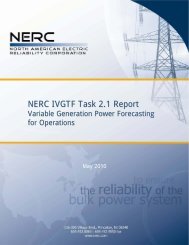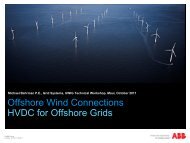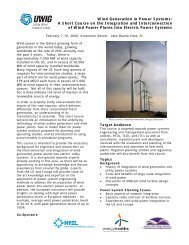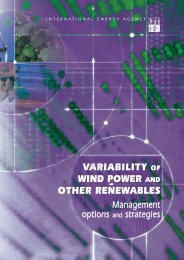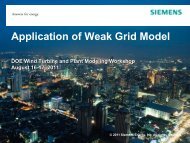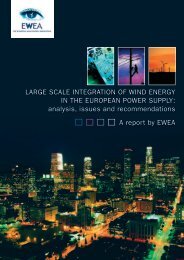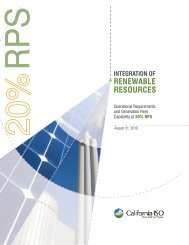Integrating Southwest Power Pool Wind to Southeast Electricity ...
Integrating Southwest Power Pool Wind to Southeast Electricity ...
Integrating Southwest Power Pool Wind to Southeast Electricity ...
You also want an ePaper? Increase the reach of your titles
YUMPU automatically turns print PDFs into web optimized ePapers that Google loves.
from the participating utilities at the time of the study, in reality, the plant mix may be<br />
different due <strong>to</strong> impending EPA regulations.<br />
Despite these assumptions, the results of the study provide insights as <strong>to</strong> the balancing impacts<br />
associated with the high wind build-out in SPP and as <strong>to</strong> the benefits of increasing levels of<br />
coordination across SPP and SERC BAs in responding <strong>to</strong> those balancing impacts. Given the<br />
assumptions and the nature of future scenario production cost modeling, the insights tend <strong>to</strong> be<br />
based more on the order of magnitude and trends between results than the absolute value of the<br />
results presented.<br />
System and Cost Impacts of High <strong>Wind</strong><br />
Although the focus of the study was not <strong>to</strong> conduct an evaluation of all system impacts of 48 GW<br />
of wind on the SPP/SERC region, the analysis and modeling does provide some insight as <strong>to</strong><br />
certain aspects of the impact of increasing wind penetration on the unconstrained system when<br />
comparing the results between the 14 GW and 48 GW installed wind cases.<br />
Cost Impacts<br />
The increase of 34 GW of wind in SPP (from 14 GW <strong>to</strong> 48 GW) results in a <strong>to</strong>tal production cost<br />
reduction of approximately $5.4 billion or $4/MWh of demand. This cost reduction represents<br />
the reduction in fuel costs from the wind generation and does not consider the offsetting cost <strong>to</strong><br />
purchase the wind energy or the capital/O&M costs <strong>to</strong> build the wind plants.<br />
Comparison of the Scenario #1 and Scenario #1 proxy cases show that the costs of the intra-hour<br />
variability and uncertainty and the day ahead uncertainty for the <strong>to</strong>tal 48 GW of wind in the High<br />
<strong>Wind</strong> Transfer cases are approximately $0.6/MWh of load, or $5/MWh of wind, for Scenario 1.<br />
This value represents most of the balancing cost that is reported in many studies as an<br />
“integration cost.” As such, the $5/MWh of wind value is on the low end of results reported in<br />
similar studies. This may be due <strong>to</strong> the value not including a cost associated with the inter-hour<br />
variability (movement of conventional units <strong>to</strong> follow the perfectly known variation of wind<br />
across the hours) and the unconstrained transmission. It should also be noted that this value does<br />
not include any capital costs for the wind generation or transmission <strong>to</strong> deliver the wind or costs<br />
associated with increased cycling of conventional plants due <strong>to</strong> increased ramping and start/s<strong>to</strong>p<br />
operations. The analysis does show, however, that the number of conventional genera<strong>to</strong>r starts<br />
does generally increase as the wind increases, but not as significantly as might be expected for<br />
48 GW of wind.<br />
Generation and Reliability Impacts<br />
The addition of 34 GW of wind in SPP (14 GW <strong>to</strong> 48 GW) for the High <strong>Wind</strong> Transfer Cases<br />
results in wind primarily displacing combined cycle gas (CC) and coal usage. Aggregate<br />
capacity fac<strong>to</strong>rs for coal and CCs across the SPP/SERC footprint drop approximately 7-8% when<br />
wind was added. This relates <strong>to</strong> the addition of the wind without retiring any conventional<br />
generation assumption described above and may mean some units would not be present (either<br />
retired or not built) in a high wind system. Based on the assumptions in the model on the relative<br />
6-2




